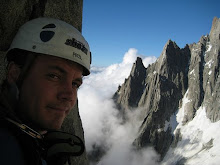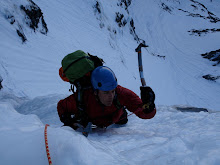In July 2012, I travelled to Africa for a look around and hoping to climb some stuff along the way. I ended up climbing the north face of Mt Kenya twice and cruising up the Machame route on Mt Kenya which was a bit of fun and quite easy. The diving in Zanzibar and the animals in the Masai Mara national park were also highlights. Below is an article I wrote for Vertical Life magazine on my solo ascent of the North Face of Mt Kenya. enjoy.
For photos follow this link.
link to photos.
FINDING THE BALANCE
I couldn’t sleep. Every possible scenario was running through my mind in a mixture of anticipation and excitement. In a few hours I would be climbing the 800m North Face of Mt Kenya alone, drawing on years of accumulated experience to not just succeed but to survive. These emotions were familiar companions before a big climb. Many previous summit days had followed sleepless nights; the only difference was this time I would be without a partner to share the climbing, the route- finding and the experience. It was my time, my experience. In a few hours I would be doing what I had been planning for months.
In July last year I travelled to East Africa with the goals of climbing Mt Kenya (5199m) and Mt Kilimanjaro (5900m) and in the process experiencing some of Africa. In terms of climbing, Mt Kenya held the most appeal. It’s a beautiful rocky mountain capped by the twin peaks of Nelion (5188m) and Batian (5199m). It has a rich climbing history with technical routes on both rock and ice. Friends from Adelaide had visited in 2008 and climbed the Standard North Face route on Batian in three days and raved about it and the mountain’s flora and fauna.
On the first day, we squeezed into a local bus for four hours in moderately crazy traffic to make the journey from Nairobi to Nanyuki, near the base of Mt Kenya and the start of the Sirimon Route. The following day, we picked up our porters and begin the two-day walk twards the North Face and Shipton’s Hut (4200m). Mt Kenya was visible for most of the walk in, soaring into the sky and looking rather intimidating. Setting out from the hut the next day, Kate and I acclimatised by trekking up Point Lenana (4985m), the peak most visitors to Mt Kenya climb.
It had been a year since I’d been in the mountains, climbing, exploring and pushing body and mind beyond their normal limits. This is what I come to the mountains for – that intensity so often missing from everyday life.
The alarm sounded at 4.30am. I scoffed some breakfast and five cups of tea, shouldered my pack and began the one-hour approach to the base of the route through the pre-dawn gloom. Light filled the sky as I began climbing at 6.20am, carrying only a litre of water, some chocolate bars, energy gels and a light down jacket. I had a 60m, 8mm rope, some wires and a few cams to protect myself while climbing or to allow safe retreat if the fear took me.
I have long been fascinated by the experience of soloing on rock and ice, and have regularly soloed long routes at Araps and shorter routes on the solid gritstone crags of England’s Peak District. I feel quite comfortable up to grade 15. Soloing easy routes allows a reasonable margin of safety and evokes a cerebral experience akin to meditation. There’s nothing to worry about but the rock and the moves, the focus of making sure every one is 100 per cent solid, no ropes or gear to distract you.
The first eight pitches had moves up to grade 15 on mostly solid rock following a gully system that led into a big amphitheatre on the North Face. After an hour and a half, I clambered into the amphitheatre, psyched to be moving fast and way ahead of schedule. I was at nearly 5000m and feeling strong. My detailed route description led me up the hard variation of the crux, Firmin’s Tower. I uncoiled the rope and dragged it behind me rather than carry dead weight on my back.
Despite the guide, route-finding was a little confusing, so I followed my instincts and the odd bit of fixed gear. Every move was deliberate and positive, the years of climbing and soloing paying off. I slowed as the difficulty increased. My senses were heightened and concentration left no room for fear. As I climbed the amazing cracks for 150m up Firmin’s Tower, I leapfrogged cams attached to daisy chains to protect the grade-18 climbing.
The weather was holding and it was only 11am when I reached the top of the Tower, where I came across some peanut shells left by the previous party on the route. I knew this was their high point after a 24-hour day. I felt in total control and kept moving, intermittently forcing myself to drink water and suck gels.
After Firmin’s Tower a few more pitches led to the summit ridge and some exposed climbing toward the summit of Batian, still another 400m away. Route-finding proved challenging because the safest and fastest route weaved across the ridge between pinnacles and along ice-covered ledges. From the ridge, I could see in every direction. The South Face was covered in ice and snow; treacherous and foreboding without crampons and ice tools.
After traversing along some easy ledges I came to the most exposed part of the route; the traverse of Shipton’s Notch, which involved some extremely exposed moves across a short wall blessed with hundreds of metres of air below it. This was followed by a ten-metre-long narrow cheval ridge, so narrow I had to shuffle along with a leg either side. With amazing 360-degree vistas, the exposure was incredible. With only Kate and a few people watching my progress from the hut 1000m below, I had the entire mountain to myself.
I arrived at the summit around 12.30pm, relieved, but not relaxed; I still had the descent to negotiate. The nearby summit of Nelion seemed very close. Photos are a poor simulacra of the panorama, unable to capture the profound experience, but I snapped a few anyway to record the moment. During intense experiences, the mind blocks out seemingly irrelevant or trivial occurrences and it is only afterwards when looking back on the photos, however inadequate they are, that I can recall and appreciate those otherwise lost moments.
I began the descent in in a state of complete concentration, a combination of scrambling and abseiling off pitons and old pieces of cord. Switched into auto pilot mode, the motions of descent became mechanical. Setup. Check. Double check. It wasn’t over till I was back on the ground.
Abseiling down Firmin’s Tower back to the amphitheatre required some rope-stretching abseils as more than once I only just reached the next set of anchors. On the last abseil into the amphitheatre, I accidentally kicked a huge block of rock, it wobbled, then teetered, then fell onto the excess rope lying on the ground. This caused me some concern. Most of the rope I needed to safely descend now lay pinned under a two-tonne boulder.
By some stroke of luck, there was a fine layer of dirt over the ground and I could pull all the rope out from under the sheet of rock. I continued descending, scrambling and abseiling further into the amphitheatre and then gully, arriving at the base of the climb at 4.30pm, a bit tired but happy, relieved and satisfied. I spent a few minutes alone there, absorbing the experience before Kate and some tourists walked up to meet me.
It was strange seeing people again after my solo adventure and it brought reality back quickly. It had been a long day of continuous concentration and exertion, those essential components of a rich, unadulterated experience. It always takes a few days, weeks or sometimes months for the experience and adventure to sink in. After more than 18 years of climbing, I have realised I need those intense adventures to renew my psyche and maintain balance in a busy lifestyle, and combining it with travel in new countries and meeting new people makes the journey that little bit more rewarding. As the years progress, finding such intense experiences becomes more difficult and seems to require more risk. Finding balance is always a challenge.
After a safari to see the animals in the Masai Mara and Lake Nakura national parks, we walked up Mt Kilimanjaro (5900m). We did it with a few other tourists, most of who were unaware the more beautiful and inspiring mountain of Mt Kenya, and its promise of amazing adventure, were only a few hours north. When I look back now, the solo of Mt Kenya stands out as an incredibly vivid experience. Sure, the memories will dull with time, but the balance was restored, if only temporarily •









































